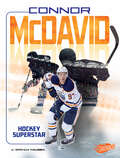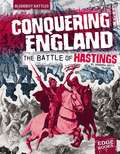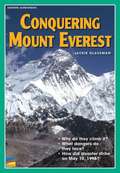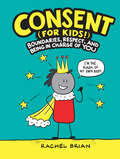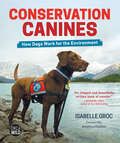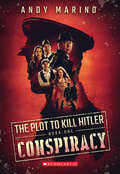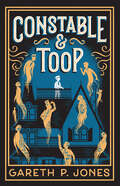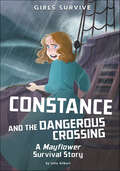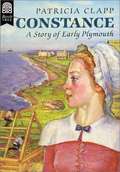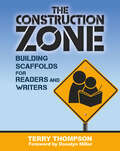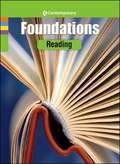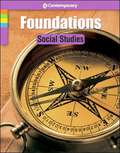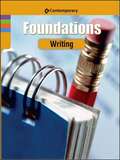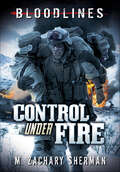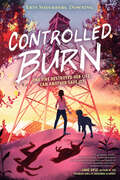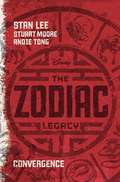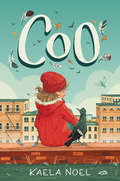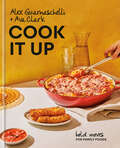- Table View
- List View
Connor McDavid: Hockey Superstar (Superstars Of Sports Ser.)
by Brenda HaugenConnor McDavid is no stranger to great hockey achievements. This focused center's time spent in junior leagues and later the Ontario Hockey League set him up for his big step to the NHL. Once he got there, Connor went on to become a leading season scorer and the youngest team captain in NHL history. Learn about Connor's path to stardom and the major highlights of his bright NHL career.
Conquering England: The Battle of Hastings (Bloodiest Battles Ser.)
by Barbara DavisDiscover the stories behind some of history’s deadliest battles. Each book presents the basics of each event, including the forces engaged on each side, the weapons they used, and the aftermath of these epic clashes. Lexile Measure: 800L
Conquering Mount Everest
by Alison Adams Jackie GlassmanFind out about Mount Everest and the daring people who have tried to reach its summit.
Consent (for Kids!): Boundaries, Respect, and Being in Charge of YOU
by Rachel Brianp.p1 {margin: 0.0px 0.0px 0.0px 0.0px; font: 12.0px Times} p.p2 {margin: 0.0px 0.0px 0.0px 0.0px; font: 12.0px Times; min-height: 14.0px} With clear explanations, fun illustrations, and expertly-presented information, Consent (for Kids!) is an empowering introduction to consent, bodily autonomy, and how to respect yourself and others. Consent is like being ruler of your own country...population: YOU. This is a smart, playful guide to consent and bodily autonomy, packed with bright and energetic illustrations. Readers will learn about boundaries and how to set them; ways to respect themselves and others; what to do if someone makes them feel uncomfortable or unsafe; and much more. Along the way, they'll be encouraged to reflect on (and improve!) their own behavior and to practice consent in their daily lives. Whether you're looking for a consent primer to share with a friend or searching for a way to talk to your child about what it means to be in control of their own body and respect others', look no further! This humorous and insightful book from the co-creator of the viral "Tea Consent" video is the perfect teaching tool, conversation starter, and insightful, empowering resource for educators, kids, and families everywhere.
Conservar los alimentos (¡Arriba la Lectura!, Level U #48)
by Phillip SimpsonNIMAC-sourced textbook
Conservation Canines: How Dogs Work for the Environment (Orca Wild #7)
by Isabelle GrocKey Selling Points The book examines how dogs are chosen and trained for conservation work and details the kind of work they do all over the world, in Africa, Italy, Portugal, France, Australia, Haida Gwaii and the United States. The author is a highly respected photojournalist, filmmaker and the author of Gone is Gone: Wildlife Under Threat and Sea Otters: A Survival Story, which are also part of the Orca Wild series. Isabelle Groc's stunning photos of working dogs give the book a hands-on feel. For fans of the TV show Dogs With Jobs—but for the environment! Includes a foreword by award-winning actor, director, producer and author Anjelica Huston.
Conspiracy: Conspiracy (The Plot to Kill Hitler #1)
by Andy MarinoBased on the real-life scheme to take down one of history's greatest monsters, this heart-pounding trilogy puts two courageous kids at the center of the plot to kill Adolf Hitler.Berlin, November 1943. With bombing raids commencing, the city is blanketed by explosions.Siblings Gerta and Max Hoffmann live a surprisingly carefree childhood amid the raids. Berlin is a city going about its business, even as it's attacked almost nightly.But one night, the air raid sirens wail, and the Hoffmanns' neighborhood is hit. A mortally wounded man comes to their door, begging to be let in. He asks for Karl Hoffmann, their father. Gerta and Max watch as Karl tries in vain to save the man's life.Before he dies, the stranger gives their father a bloodstained packet of documents, along with a message: "For the sake of humanity, the Führer must die. Finish it, Karl!"Based on real events, this is the story of two children swept up in a fight for the soul of Germany -- and the world.
Conspiracy: Nixon, Watergate, and Democracy's Defenders
by P. O’Connell PearsonThe story of President Richard Nixon and those who fought against him comes to life in this insightful and accessible nonfiction middle grade book from the author of Fly Girls and Fighting for the Forest.The Watergate scandal created one of the greatest constitutional crises in American history. When the House Judiciary Committee approved three articles of impeachment against President Richard Nixon and the Supreme Court ruled that he had to turn over to Congress the tapes that proved the claims against him, he realized his support in the Senate had collapsed. He resigned rather than face almost certain conviction on abuse of power and obstruction of justice. We know the villain&’s story well, but what about the heroes? When the country&’s own leader turned his back on the Constitution, who was there to defend it? Conspiracy is about the reporters, prosecutors, judges, justices, members of Congress, and members of the public who supported and defended the Constitution when it needed it most.
Constable & Toop
by Gareth P. JonesSomething mysterious and terrible is happening throughout Victorian London: Ghosts are disappearing. When this reaches the attention of the Ghost Bureau, the diligent but clueless Mr. Lapsewood, a paranormal paper-pusher, is sent to investigate, and what he discovers is grave. The Black Rot has arrived—a voracious spiritual infestation whereby empty haunted houses suck in unsuspecting ghosts and imprison them. Lapsewood’s investigation weaves through the plotlines of several other memorable characters—both living and dead—including an undertaker’s son who can see ghosts, a serial throat-slasher reminiscent of Jack the Ripper, an evangelical exorcist, and many more. The living and dead must work together if they hope to destroy the Black Rot—before it destroys both the ghost and human worlds. This highly atmospheric and bitingly funny ghost story by successful British author Gareth P. Jones will delight fans of Eva Ibbotson and Neil Gaiman.
Constance and the Dangerous Crossing: A Mayflower Survival Story (Girls Survive)
by Julie GilbertFifteen-year-old Constance is looking forward to a new life in the New World. There’s nothing left for her in England—no family and no future. She agrees to set sail on the Mayflower, along with her employer. But the ocean crossing is harder than anyone anticipated, and the journey is riddled with dangerous obstacles. Will Constance live to see the New World, or will she and the other passengers be lost at sea?
Constance: A Story of Early Plymouth
by Patricia C. ClappThe Indians started some sort of rhythmic chanting, with a clapping of their hands to accent it, and I sat a little apart at, one of the fires listening. It was a strange sound that somehow sent my blood pulsing more quickly and made me wish I could stand up and dance round and round the fire, but this I knew would not be fitting. Of a sudden I was aware of someone beside me, and turning, saw Ted Leister easing himself down to the ground. I thought it best to say nothing of the disagreement he and t'other Ted had, so I spoke of the singing. "It nigh makes me giddy," I said. "'Tis not at all like English singing." "If it makes you giddy, lie back and close your eyes," Ted Leister told me. "'Twill soon pass." I did as he suggested, and I could feel the very earth under me throbbing from the beat and beat and beat of the voices and hands. My eyes were closed, but the dizziness got no better and I moved to sit up when I felt Ted's hand push me gently back again, and then he kissed me.
Construction Zone: Building Scaffolds for Readers and Writers
by Terry ThompsonInstructional scaffolding is an essential part of teaching literacy. But what is scaffolding exactly? What does it look like in a classroom, and how can we improve the ways we use it? Despite its prominence in the repertoire of teaching strategies, scaffolding remains a vague concept for many teachers. ' In essence, scaffolding is the idea of supporting students as they build independence. In The Construction Zone: Building Scaffolding for Readers and Writers, Terry Thompson identifies four critical processes to deepen your understanding and improve your practice of instructional scaffolding: ·' ' ' ' ' ' ' ' Finding and maintaining a specific focus ·' ' ' ' ' ' ' ' Practicing flexibility in planning and delivering instruction ·' ' ' ' ' ' ' ' Giving constructive feedback in response to student efforts ·' ' ' ' ' ' ' ' Monitoring to ensure that students are working at optimal levels of responsibility Thompson' encourages teachers to enhance their use of the traditional gradual release process through five actionable steps: show, share, support, sustain, and survey, and in doing so provides procedures and techniques to help them establish and maintain strong scaffolds throughout the instructional day. The Construction Zone is written from the teacher's perspective and urges educators to fully embrace their role in the scaffolding process while staying mindful of the effect it has on students. ' Taking a student from dependence upon the teacher to independent learning is what teaching is all about, and instructional scaffolding is key to accomplishing this goal. Regardless of where you are in your understanding of instructional scaffolding, The Construction Zone will raise your level of awareness around your instructional practices and the ways you scaffold students to independence.' '
Consumer Math
by Larry D. Lemon Larry L. HallPrepare your students for making financial decisions with instruction about credit card charges, taxes, interest on loans and savings, personal banking, and costs of transportation, food, clothing, utilities, insurance, and filling out income tax forms. Being a good steward of the Lord's money is the primary emphasis. The student text presents concepts with numerous examples and step-by-step explanations. Each section contains five cumulative review problems, and each chapter contains a chapter review.
Contemporary Foundations: Reading
by McGraw-HillContemporary's Foundations series helps students improve their basic skills. Each book provides skill instruction, offers interesting passages to study, and furnishes opportunities for practice. Foundations provides meaningful contexts for learning, using language which is easy to understand. About Foundations: Reading, Revised Edition: Foundations: Reading will help students improve their reading ability, as well as their writing and thinking skills. Foundations: Reading is divided into four units: Practical Reading: ''survival'' reading that you do everyday. Practical reading includes instructions, advertisements, and explanations. Reading Nonfiction: writing based on facts. Nonfiction includes newspaper and magazine articles, books about real people and real events, and encyclopedia articles. Reading Poetry: verse that captures a person's feelings. Learning to recognize form, rhythm, rhyme, and images will help you read and appreciate poetry. Reading Short Fiction: stories created from an author's imagination. Characters, setting, plot, and theme are important elements in every story. These special features in Foundations: Reading will help students practice language skills: Writing Workshops: detailed instructions that will guide the student through the four-step writing process: prewriting, drafting, revising, and editing Language Tips: explanations, pronunciations, study hints, and background information that will help the student understand what he or she is reading Test Skills: a reminder that this skill is often tested on standardized tests Posttest: a test, evaluation chart, and answer key, to gauge the mastery of each skill. Revised Edition Features: New language tips, Updated content, including revised passages, updated graphs and images, More exercises. About the Series: In Foundations: Reading, students will read practical information, nonfiction, poetry, and short stories. They will learn to find the main point and the details; identify fact, opinion, and bias; make inferences; read photographs and cartoons; and understand rhythm, rhyme, plot, and theme. Writing Workshops, Language Tips, and prereading questions are designed to improve reading, writing, and thinking skills. In Foundations: Writing, students will practice the four steps to writing an essay: prewriting, drafting, revising, and editing. They will read and write five kinds of essays: descriptive essays, personal narratives, how-to essays, essays of example, and comparison-and-contrast essays. A language-skills workbook provides grammar, punctuation, and sentence structure practice. In Your Journal, With a Partner, and Language Tips will help students become better writers, and better readers and thinkers as well. In Foundations: Science, students will learn about the human body, plant biology, physics, chemistry, and Earth science. They will practice putting events in order; reading diagrams, charts, and graphs; using the scientific method; and making comparisons and contrasts. Try It yourself! activities will guide students through simple experiments so they will have a better understanding of what they have been reading about. Writing Workshops and Language Tips will help students use their reading and writing skills to think about science topics. In Foundations: Social Studies, students will learn about world history, U.S. history, civics and government, geography, and economics. They will summarize, make predictions, infer the main idea of cartoons, find information on maps, and read various kinds of graphs. Background Information, Language Tips, and Writing Workshops will let students use what they already know as they read and write about social studies topics. The revised edition includes a new World History chapter. In Foundations: Math, students will practice using whole numbers, money, decimals, fractions, ratios, and percents. Exercises will help students review the addition, subtraction, multiplication, and division facts; round numbers; estimate answers; and solve word problems. Math Notes, On their Calculator, and Language ...
Contemporary Foundations: Science
by Wright Group/McGraw-HillContemporary's Foundations series helps students improve their basic skills. Each book provides skill instruction, offers interesting passages to study, and furnishes opportunities for practice.Foundations provides meaningful contexts for learning, using language which is easy to understand. About Foundations: Science, Revised Edition : In Foundations: Science, students will learn about the human body, plant biology, physics, chemistry, and Earth science. They will practice putting events in order; reading diagrams, charts, and graphs; using the scientific method; and making comparisons and contrasts. Try It yourself! activities will guide students through simple experiments so they will have a better understanding of what they have been reading about.Writing Workshops and Language Tips will help students use their reading and writing skills to think about science topics. About the Series: In Foundations: Reading, students will read practical information, nonfiction, poetry, and short stories. They will learn to find the main point and the details; identify fact, opinion, and bias; make inferences; read photographs and cartoons; and understand rhythm, rhyme, plot, and theme. Writing Workshops, Language Tips, and prereading questions are designed to improve reading, writing, and thinking skills. In Foundations: Writing, students will practice the four steps to writing an essay: prewriting, drafting, revising, and editing. They will read and write five kinds of essays: descriptive essays, personal narratives, how-to essays, essays of example, and comparison-and-contrast essays. A language-skills workbook provides grammar, punctuation, and sentence structure practice. In Your Journal, With a Partner, and Language Tips will help students become better writers, and better readers and thinkers as well. In Foundations: Science, students will learn about the human body, plant biology, physics, chemistry, and Earth science. They will practice putting events in order; reading diagrams, charts, and graphs; using the scientific method; and making comparisons and contrasts. Try It yourself! activities will guide students through simple experiments so they will have a better understanding of what they have been reading about. Writing Workshops and Language Tips will help students use their reading and writing skills to think about science topics. In Foundations: Social Studies, students will learn about world history, U.S. history, civics and government, geography, and economics. They will summarize, make predictions, infer the main idea of cartoons, find information on maps, and read various kinds of graphs. Background Information, Language Tips, and Writing Workshops will let students use what they already know as they read and write about social studies topics. The revised edition includes a new World History chapter. In Foundations: Math, students will practice using whole numbers, money, decimals, fractions, ratios, and percents. Exercises will help students review the addition, subtraction, multiplication, and division facts; round numbers; estimate answers; and solve word problems. Math Notes, On their Calculator, and Language Tips will help students improve math skills. The revised edition of Math is a major revision. The language has been updated to make the material even easier to follow than before.
Contemporary Foundations: Social Studies
by Wright Group/McGraw-HillContemporary'sFoundationsseries helps students improve their basic skills. Each book provides skill instruction, offers interesting passages to study, and furnishes opportunities for practice.Foundationsprovides meaningful contexts for learning, using language which is easy to understand. AboutFoundations: Social Studies, Revised Edition : In Foundations: Social Studies, students will learn about world history, U.S. history, civics and government, geography, and economics. They will summarize, make predictions, infer the main idea of cartoons, find information on maps, and read various kinds of graphs. Background Information,Language Tips, andWriting Workshops will let students use what they already know as they read and write about social studies topics. The revised edition includes a new World History chapter. About the Series: In Foundations: Reading, students will read practical information, nonfiction, poetry, and short stories. They will learn to find the main point and the details; identify fact, opinion, and bias; make inferences; read photographs and cartoons; and understand rhythm, rhyme, plot, and theme. Writing Workshops, Language Tips, and prereading questions are designed to improve reading, writing, and thinking skills. In Foundations: Writing, students will practice the four steps to writing an essay: prewriting, drafting, revising, and editing. They will read and write five kinds of essays: descriptive essays, personal narratives, how-to essays, essays of example, and comparison-and-contrast essays. A language-skills workbook provides grammar, punctuation, and sentence structure practice. In Your Journal, With a Partner, and Language Tipswill help students become better writers, and better readers and thinkers as well. In Foundations: Science, students will learn about the human body, plant biology, physics, chemistry, and Earth science. They will practice putting events in order; reading diagrams, charts, and graphs; using the scientific method; and making comparisons and contrasts. Try It yourself!activities will guide students through simple experiments so they will have a better understanding of what they have been reading about. Writing Workshops and Language Tips will help students use their reading and writing skills to think about science topics. In Foundations: Social Studies, students will learn about world history, U.S. history, civics and government, geography, and economics. They will summarize, make predictions, infer the main idea of cartoons, find information on maps, and read various kinds of graphs. Background Information, Language Tips, and Writing Workshops will let students use what they already know as they read and write about social studies topics. The revised edition includes a new World History chapter. In Foundations: Math, students will practice using whole numbers, money, decimals, fractions, ratios, and percents. Exercises will help students review the addition, subtraction, multiplication, and division facts; round numbers; estimate answers; and solve word problems. Math Notes, On their Calculator, and Language Tips will help students improve math skills. The revised edition of Math is a major revision. The language has been updated to make the material even easier to follow than before. Foundations series at a glance
Contemporary Foundations: Writing
by McGraw Hill Wright GroupContemporary'sFoundationsseries helps students improve their basic skills. Each book provides skill instruction, offers interesting passages to study, and furnishes opportunities for practice.Foundationsprovides meaningful contexts for learning, using language which is easy to understand. Foundations: Writingwill help students improve their writing skills, as well as their reading and thinking skills. Part I: Writing helps students practice the four stages of the writing process: Prewriting: planning and organizing Drafting: writing by following a plan Revising: evaluating and rewriting Editing: correcting grammar, mechanics, and usage Students will learn about five types of essays and practice writing each type: Descriptive Essay Personal Narrative How-To Essay Essay of Example Comparison-and-Contrast Essay Part II: Grammar focuses on language skills that writers need to understand. Grammar: nouns, pronouns, verbs, adjectives, and adverbs Punctuation: periods, question marks, exclamation marks, commas, and semicolons Sentence Structure: incomplete sentences, run-on sentences, and comma splices The following special features will help students practice their writing skills. In Your Journal: ideas to think about and write about on your own Language Tip: explanations, pronunciations, study hints, and background information that will help students understand what they read Test Skills: a reminder that this skill is often tested on standardized tests With a Partner: reading, writing, and thinking activities to do with a classmate, family member, or friend Posttest: a test, evaluation chart, and answer key to guage skill mastery Revised Edition Features: New language tips Updated content, including revised passages, updated graphs and images More exercises About the Series: In Foundations: Reading, students will read practical information, nonfiction, poetry, and short stories. They will learn to find the main point and the details; identify fact, opinion, and bias; make inferences; read photographs and cartoons; and understand rhythm, rhyme, plot, and theme. Writing Workshops, Language Tips, and prereading questions are designed to improve reading, writing, and thinking skills. In Foundations: Writing, students will practice the four steps to writing an essay: prewriting, drafting, revising, and editing. They will read and write five kinds of essays: descriptive essays, personal narratives, how-to essays, essays of example, and comparison-and-contrast essays. A language-skills workbook provides grammar, punctuation, and sentence structure practice. In Your Journal, With a Partner, and Language Tipswill help students become better writers, and better readers and thinkers as well. In Foundations: Science, students will learn about the human body, plant biology, physics, chemistry, and Earth science. They will practice putting events in order; reading diagrams, charts, and graphs; using the scientific method; and making comparisons and contrasts. Try It yourself!activities will guide students through simple experiments so they will have a better understanding of what they have been reading about. Writing Workshops and Language Tips will help students use their reading and writing skills to think about science topics. In Foundations: Social Studies, students will learn about world history, U.S. history, civics and government, geography, and economics. They will summarize, make predictions, infer the main idea of cartoons, find information on maps, and read various kinds of graphs. Background Information, Language Tips, and Writing Workshops will let students use what they already know as they read and write about social studies topics. The revised edition includes a new World History chapter. In Foundations: Math, students will practice using whole numbers, money, decimals, fractions, ratios, and percents. Exercises will help students review the addition, subtraction, multiplication, and division facts; round numbers; estimate answers; and solve word problems. Math Notes, On their Calculator, and Language Ti...
Content Essentials For Science, Student Handbook, Level C
by Margarita CalderonYour book has two parts, you can use the first part to learn about science topics. If you need help reading or writing about science, use the second part.
Context Clues: Reading Comprehension Activities (Reading Level 3.5 - 5.0)
by EdupressReinforce critical reading skills with a diverse range of classroom activities! Detailed teacher instruction pages. Leveled reading passages and reproducible activities. Individual, small-group and whole-class activities.
Control Under Fire (Bloodlines)
by M. Zachary ShermanTechnology and air superiority equals success in modern warfare. But even during the War in Afghanistan, satellite recon and smart bombs cannot replace soldiers on the ground. When a SEAL team SeaHawk helicopter goes down in the icy mountains of Kandahar, Lieutenant Lester Donovan must make a difficult decision: follow orders or go "off mission" and save his fellow soldiers. With Taliban terrorists at every turn, neither decision will be easy. He'll need his instincts and some high-tech weaponry to get off of the hillside and back to base alive!
Controlled Burn
by Erin Soderberg DowningFrom acclaimed middle-grade and chapter-book author, Erin Soderberg Downing, Controlled Burn is a story that blends family, friendship, fire, and the rocky path toward healing our deepest fears.Twelve-year-old Maia’s parents say she’s lucky she noticed something as early as she did. Lucky to have smelled the smoke, lucky to have pulled her sister, Amelia, out of their burning house. But is it really “lucky” when Amelia’s stuck in the hospital, covered in burns? And is it “lucky” when Maia knows it was her candle, left unattended, that started the fire in the first place?When she’s sent to spend the summer with her grandparents in Northern Minnesota while her sister heals, Maia discovers that her anxieties and demons are intent on following her wherever she goes…unless she can figure out how to overcome them. But what if she can’t? Maia barely knows her grandparents, she desperately misses her sister and home, and she’s not thrilled to be spending the summer with Grandpa Howard on his daily motorcycle rides out to the middle of the woods, where he spends all day keeping watch for forest fires. There are no kids her age in Gram and Pop’s small town at “the end of the road”—just the chatty nine-year-old neighbor who is intent on getting his Bear Scout badge at all costs, and a friendly, stray dog who’s been lurking around.But Maia will soon learn that nature is a powerful teacher, and sometimes our greatest strengths show themselves when we have to be there for someone else. As she begins to figure out how to face her guilt and paralyzing fears, she’ll discover there’s a fine line between fear and adventure. And when danger strikes again, Maia must summon all her bravery and overcome her self-doubt if she wants to save those she loves most.
Convergence (The Zodiac Legacy #1)
by Stan Lee Andie Tong Stuart MooreStan Lee presents a brand new, magical, super-powered adventure! When twelve magical superpowers are unleashed on the world, a Chinese-America teenager named Steven will be thrown into the middle of an epic global chase. He'll have to master strange powers, outrun super-powered mercenaries, and unlock the mysterious powers of the Zodiac.
Coo
by Kaela NoelIn this exceptional debut, one young girl’s determination to save the flock she calls family creates a lasting impact on her community and in her heart. Gorgeous and literary, this is an unforgettable animal story about friendship, family, home, and belonging. For readers who love books by Kate DiCamillo and Katherine Applegate. Ten years ago, an impossible thing happened: a flock of pigeons picked up a human baby who had been abandoned in an empty lot and carried her, bundled in blankets, to their roof. Coo has lived her entire life on the rooftop with the pigeons who saved her. It’s the only home she’s ever known. But then a hungry hawk nearly kills Burr, the pigeon she loves most, and leaves him gravely hurt.Coo must make a perilous trip to the ground for the first time to find Tully, a retired postal worker who occasionally feeds Coo’s flock, and who can heal injured birds. Tully mends Burr’s broken wing and coaxes Coo from her isolated life. Living with Tully, Coo experiences warmth, safety, and human relationships for the first time. But just as Coo is beginning to blossom, she learns the human world is infinitely more complex—and cruel—than she could have imagined. This remarkable debut novel will captivate readers from the very first line. Coo examines the bonds that make us family, the possibilities of love, and the importance of being true to yourself. Fans of Katherine Applegate, Kate DiCamillo, and Barbara O’Connor will devour this extraordinary story. Features black-and-white spot art throughout.
Cook It Up: Bold Moves for Family Foods: A Cookbook
by Alex Guarnaschelli Ava Clark75 family favorites get leveled up to be even bolder, saucier, cheesier, and crisper thanks to Iron Chef Alex Guarnaschelli and her highly opinionated chef-in-training daughter Ava!From the time she was old enough to hold a fork, Ava has been at Alex&’s side in the kitchen, whether eating lusciously cheesy gnocchi at Alex&’s New York City restaurant, Butter, or making classic French omelets with her famous Iron Chef mom. While Alex turns to treasured cookbooks for inspiration, Ava scrolls through TikTok—and now as a teenager, Ava is teaching Alex a thing or two.Through seventy-five witty and informative recipes, Alex and Ava share a repertoire of dishes that define their modern family meals: bold flavored, comforting, satisfying, and always supremely delicious. Side by side, they cook their way through family favorites like Blueberry Pie from Alex&’s mom, a legendary cookbook editor, and Nanny Ida&’s Crisp Potato Latkes. Tips and notes offer great cooking advice for achieving the fluffiest frittatas (add water, never milk) and how to season and mix meatballs so they always stay juicy (spread the mixture up around the sides of the bowl and then season). There&’s even a bonus recipe for dog biscuits, inspired by Alex and Ava&’s family dog, Leon!Cooking with authority is learned and earned in this smart and joyous cookbook that celebrates a mother-daughter bond that&’s stronger than the even the most garlicky garlic bread (the secret is—surprise—lots of shallots!).

